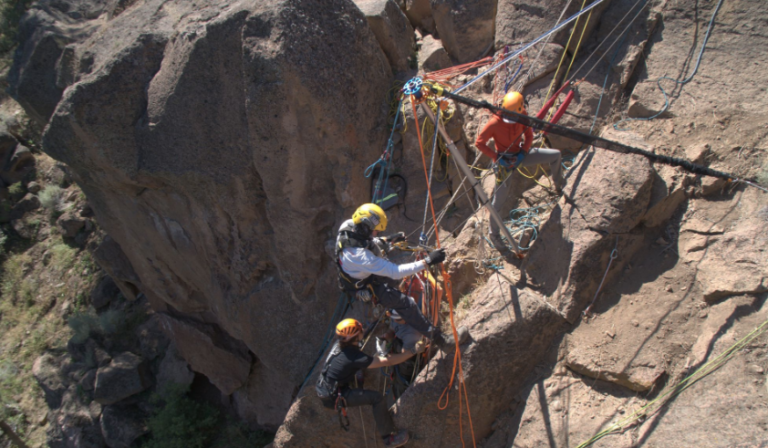Rope Rescue Hardware and Systems: A Comprehensive Guide
Effective rope rescue operations hinge on the proper use and maintenance of hardware and systems. For fire service and search and rescue (SAR) teams, understanding how to select, manage, and maintain rescue equipment is crucial for ensuring safety and operational efficiency. This guide delves into the principles, considerations, and practices that form the backbone of high-angle rescue operations.
The Role of Hardware in Rescue Systems
Rope rescue hardware functions as part of an interconnected system, where each component must work seamlessly together. Equipment must be compatible with the specific rescue scenario and used within its designated safe working load limits.
Key Considerations:
- Always select hardware that aligns with the mission’s demands.
- Ensure all components are sized and rated appropriately.
- Follow manufacturer instructions for use, and regularly inspect equipment for wear or damage.
- Using damaged equipment can compromise the entire system, posing serious risks to rescuers and victims alike.
Safety as a Cornerstone of Rescue Operations
Safety underpins every aspect of rope rescue. A well-designed system includes a robust safety factor, minimizing the risk of failure even under extreme conditions. Evaluating the system before deployment helps mitigate potential hazards.
Critical Safety Measures:
- Anticipate consequences of component failure and design redundancies into the system.
- Use only equipment rated for life safety applications, and adhere to national standards such as NFPA 1983.
- Maintain situational awareness during operations to adapt quickly to unforeseen challenges.
High-Angle Rescue Call Outs: Preparation and Execution
In high-angle rescue scenarios, the right equipment and approach are vital. Teams must prepare adequately and assess each situation for the safest and most efficient method of operation.
Equipment Preparation:
- Include ropes, harnesses, carabiners, pulleys, and devices for raising and lowering workers.
- Pack additional edge protection to prevent rope damage during operations.
Rescue Approach:
- Lowering a victim is often the preferred method due to its simplicity and reliance on gravity.
- In some cases, raising or a combination of raising and lowering methods may be required.
- A rapid yet calculated assessment of the scenario ensures effective action.
Equipment Selection and Considerations
Careful planning and evaluation guide the selection of rope rescue equipment. Every operation is unique, requiring tailored solutions to meet the demands of the environment and the rescue scenario.
Factors to Consider:
- Conduct a hazard analysis to identify risks inherent to the rescue environment.
- Align equipment capabilities with the team’s training and staffing levels.
- Create a realistic timeline and contingency plans to address unforeseen challenges.
Selection Process:
- Assess the type of rescue operation, such as high-angle or confined space rescue.
- Consider the environment—wet, icy, or abrasive conditions may demand specialized gear.
- Evaluate the load requirements to determine the appropriate strength and type of rope and hardware.
Types of Rope Rescue Equipment
Each piece of equipment serves a specific purpose, and understanding these roles is essential for building a reliable rescue system.
- Ropes: Lifelines for ascending, descending, and hauling.
- Anchors: Secure attachment points critical for system stability.
- Harnesses: Provide secure and ergonomic support for rescuers and victims.
- Pulleys: Reduce friction and enhance mechanical advantage in hauling systems.
- Carabiners: Connect system components and provide secure attachment points.
- Descenders and Ascenders: Control descent and facilitate upward movement.
- Belay Devices: Offer safety backups during operations.
- Helmets: Protect against falling debris and impacts.
- Rope Grabs: Secure progress capture devices used in hauling systems.
Equipment Organization and Maintenance
Proper organization ensures swift deployment during a rescue. Maintenance programs extend equipment life and maintain operational readiness.
Organizational Strategies:
- Arrange equipment for easy identification and access.
- Regularly review and update organization systems to reflect team needs and operational requirements.
Maintenance Practices:
- Implement an inspection program to identify wear and damage.
- Retire ropes and hardware at the end of their useful life, following NFPA 2500 standards.
- Keep equipment clean and free from contaminants, using appropriate cleaning methods.
The Importance of Training and Standards
Rescue operations demand a high level of skill and adherence to safety standards. Teams must continually train to maintain proficiency with equipment and techniques.
Training Focus:
- Familiarize personnel with organizational Standard Operating Procedures (SOPs).
- Conduct drills simulating real-world scenarios to build confidence and expertise.
Adherence to Standards:
- Follow national guidelines, such as NFPA 1983 for life safety ropes and hardware.
- Leverage resources from organizations like the Rigging Lab Academy and Rescue Response Gear for training and equipment needs.
Related Resources
- Selecting an Anchor: Key Considerations
- Mechanical Advantage: Basics and Beyond
- NFPA Standards Overview
Conclusion
By adopting a systematic approach to rope rescue hardware and systems, teams can operate with greater efficiency and confidence. From selecting and maintaining equipment to training and organizational strategies, each component plays a vital role in ensuring success. Emphasizing safety and adhering to established standards allow rescue teams to respond effectively, even in the most challenging scenarios.
Peace on your Days
Lance









